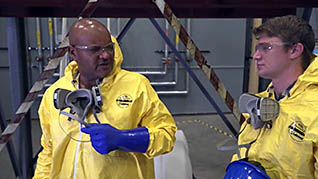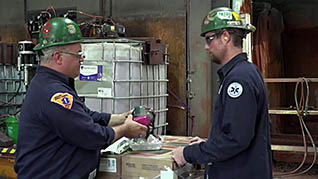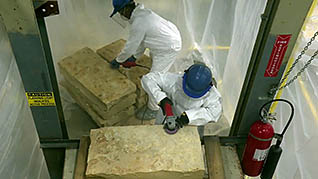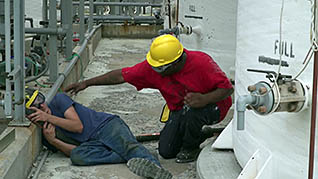Breathe Safely: The Proper Use of Respiratory Protection
- Product ID
- erisbspu_vod
- Training Time ?
- 18 to 28 minutes
- Language(s)
- English,Spanish
- Video Format
- High Definition
- Required Plugins
- None
- Number of Lessons
- 11
- Quiz Questions
- 10
- Closed Captioning
- Question Feedback
- Wrong Answer Remediation
- Lesson Bookmarking
- Downloadable Resources



Exposure to the mists, dusts, gases, and fumes of hazardous chemicals can cause cancer, lung damage, and harm to the respiratory and central nervous systems. High levels of toxic gases and fumes can cause loss of consciousness and even death. This safety training course provides an understanding of respiratory hazards and how to use respiratory protection.
Viewers learn about the wide range of respiratory protection, from simple NIOSH approved dust masks to the complex protection needed in Immediately Dangerous to Life and Health (IDLH) atmospheres. Environments that have dangerously high levels of gases or fumes, or that are deficient in oxygen, are known as IDLH atmospheres. These dangerous environments require a Self Contained Breathing Apparatus (SCBA) or a Supplied Air Respirator (SAR). This course also covers particulate filters and chemical cartridge respirators.
In addition, viewers are shown how to test a respirator, when to replace filters, and how to clean respirators. Learn how to properly use respiratory protection by completing this safety training course.
![]() This course is in the Video On Demand format, to read about Video On Demand features click here.
This course is in the Video On Demand format, to read about Video On Demand features click here.

- Full-screen video presentation
- Print certificate and wallet card
- You have 30 days to complete the course
Everyone who works in an environment with respiratory hazards
- Introduction
- The Written Respiratory Protection Program
- Medical Evaluations and Fit Testing
- Workplace Respiratory Hazards and APF’s
- Different Classes of Filters
- Types of Respirators
- Chemical Cartridge Respirators and PAPR
- Protection in an IDLH Atmosphere
- Proper Respirator Use
- Cleaning Disinfecting and Storing Respirators
- Conclusion
© Mastery Technologies, Inc.


